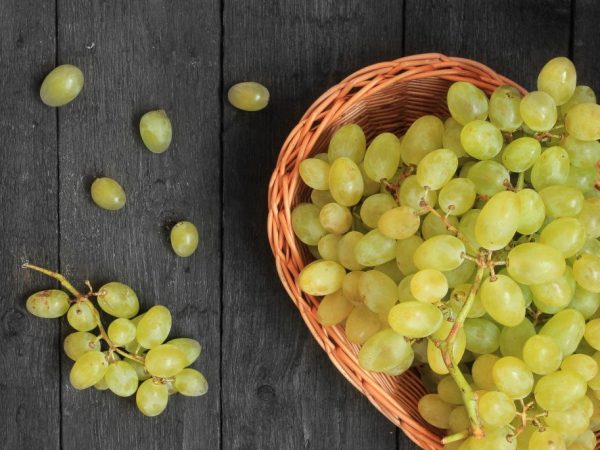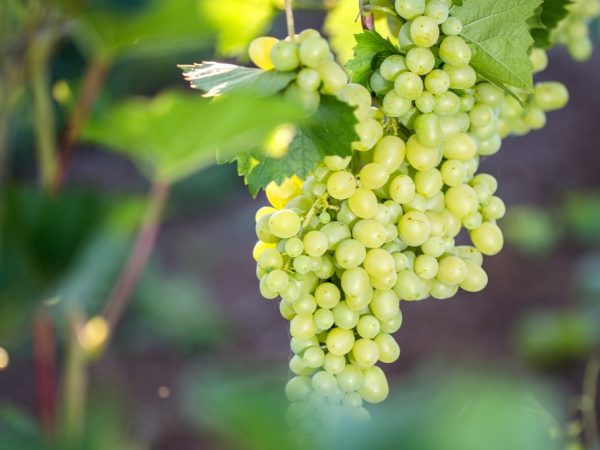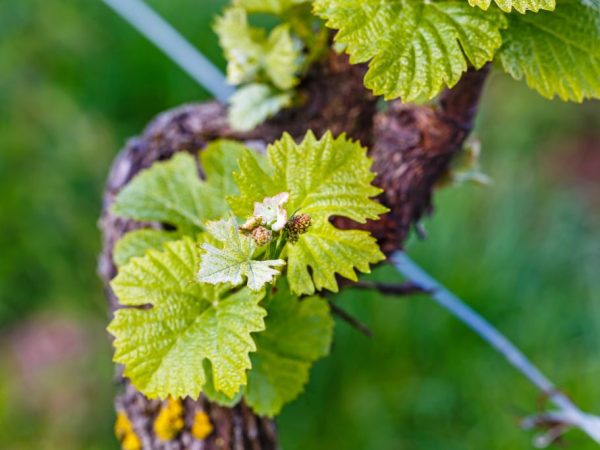Cimus grape cultivation
Many of the hybrid forms of the grape crop are popular in suburban areas. The Tsimus grape is one of them.

Cimus grape cultivation
Characteristics of the variety
In terms of ripening, Tsimus belongs to the group of very early varieties. The crop ripens within 85-90 days.
Characteristics of the bushes
The vine of this grape variety is distinguished by strong growth. Development is fast.
The bushes calmly endure frosts down to -23⁰С. Flowers on the vine are bisexual. The hallmark is an increased level of disease resistance.
Fruit characteristics
According to the description, bunches of Zimus grapes grow relatively large. The average weight of brushes with fruits is from 600 g to 1.5 kg. Each berry reaches a size of 20-25 mm and weighs about 7-8 g. Berries of this variety are classified as seedless class 3-4.
Fruit color is yellow. The pulp is juicy. The taste of the grapes is citron-nutmeg. The sourness is almost completely absent.
Growing
Compliance with all the intricacies of agricultural technology allows you to consistently get the maximum yield.
Planting in soil
When choosing a place for planting seedlings of raisins, it is taken into account that this culture requires a lot of sunlight. It is better for the gardener to avoid the proximity of the vine to structures or trees: this will not allow the berries to ripen properly. The proximity of groundwater leads to the death of bushes due to decay of the root system.
Young shoots can be planted 2 times a year: in autumn and spring. When planting in autumn, more attention is paid to protecting the seedling from winter cold.
In the fall season, grapes are planted from October to the beginning of frost. For insulation and protection, the sprouts are covered with plastic bottles with 4 holes for ventilation and oxygen access.
Spring planting is carried out when the frost season ends. Seedlings are planted on the site when a stable temperature is established.
Care
To obtain a high and high-quality grape crop, it is important not only to plant the sprout correctly, but also to grow it from a young seedling into a strong and healthy vine.
Watering

The productivity of the bush depends on the correct watering
Proper watering is the key to the health and productivity of the crop. It is worth remembering the following:
- The raisins have a great need for moisture. The average amount of fluid consumed is 30 liters of water per week.
- When planting on sandy soils, the crop's need for water increases by 1.5 times.
- When watering, it is important to keep the vines out of the water. Water is poured only under the roots of the plant.
- 2 or 3 weeks before the start of harvesting, abundant watering is stopped. Instead, light sprinkling of the soil is applied.
- During harvesting, the crop is not watered.
One of the possible ways to irrigate crops is drip irrigation. However, when planting seedlings on the site, it is permissible to lay pipes that will supply moisture. Both methods have shown themselves equally well in practice.
Top dressing
At the beginning of the season, gardeners use nitrogen fertilizer and plantfol to increase the green mass of the bush. Beforehand, they carefully study the instructions for the use of plantofol and strictly observe it.
The following nutrients are used throughout the remainder of the season:
- potassium monophosphate;
- sulfate;
- magnesium sulfate.
It is important to exercise a sense of proportion when fertilizing. An overfed vine develops slowly, which negatively affects both the yield and the general condition of the bush.
Pruning
Vine bushes are pruned to increase yields. The classic option is pruning, in which 8-12 eyes are cut off.
The bush is formed, guided by the calculation of 10-12 vines, located at 1 m in height. This is done to form 1-2 bunches on each shoot. With this formation of the bush, the brushes will grow large.
Overloading a bush usually leads to the following consequences:
- Potassium starvation culture.
- Slow ripening processes of berries.
- Loss of palatability of the fruit.
- Berry cracking, wateriness and reduced shelf life.
Weak vines are removed as needed. This allows you to more competently distribute the resource of the bush. Also, timely and competent pruning helps protect the root system in the winter.
Diseases and pests

Spraying with drugs will help maintain plant health
Grapes, like any other fruit and berry crop, are attacked by parasitic organisms and the harmful effects of diseases. However, the timely application of measures for treatment and prevention will solve these problems and save the bushes and the harvest.
The main enemies of Tsimus are:
- Spider mites. A sign of infection is dark spots on the leaves.
- Wasps.
- May beetle larvae. They are found in the soil and damage the root system of the plant.
- Leaf rollers. They cause damage to leaves and fruits.
In the spring, at the very beginning of the season, the grape bushes are processed with the Bordeaux mixture. When pruning, try to prevent infection through the cut.
Wasps are fought by installing insect traps. A mixture of sugar syrup and chlorophos must be added to the traps. Fumigation of bushes with smoke, spraying with vinegar and other culture-safe means are also used.
Protection of plant roots from May beetle larvae is carried out while digging the soil near the bushes. During this process, the larvae seen on the site are removed from the ground as far as possible from the plantings.
To prevent the transition of spider mites from the lower leaves to the higher ones, spraying with insecticides is used. These funds are used in strict accordance with the instructions.
Complex insecticides help well against attacks of leaf rollers. The use of this group of drugs also increases the level of plant protection against other pests that can cause crop loss.
Conclusion
Kishmish variety Tsimus is a hybrid seedless form of grapes grown in many summer cottages and gardens. Proper crop care allows you to get stable high yields of juicy berries with a pleasant nutmeg taste.


